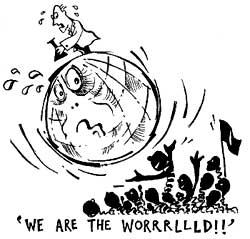Mite but mighty!
 it is a whole new twist to the very concept of geochemistry. And what are propelling the changes in outlook are millions of tiny microbes working quietly behind the scenes, literally, to effect mighty changes in the earth's interior. These microbes, hitherto neglected as subjects for study, have shot into prominence after scientists credited them to be the moving spirits behind the '80s Sierra Pelada gold-rush in Brazil.
it is a whole new twist to the very concept of geochemistry. And what are propelling the changes in outlook are millions of tiny microbes working quietly behind the scenes, literally, to effect mighty changes in the earth's interior. These microbes, hitherto neglected as subjects for study, have shot into prominence after scientists credited them to be the moving spirits behind the '80s Sierra Pelada gold-rush in Brazil.
William A Fyfe, an environmental geochemist based at the University of Western Ontario in London, Ontario, who along with his colleagues undertook a detailed study into the rich lode at Sierra Pelada said, "There is lot of evidence that microbes played a critical role.' Earlier, it was thought that the presence of gold was a result of natural ore formation. Evidence, however, points out to fossil bacteria and organic compounds in the area which was followed by careful demonstrations in the laboratory of how microbes can concentrate gold.
Precious metal aside, microbes are being held responsible for creating and arranging the rocks, seas, oils, soils, gases, metals and minerals that make up the earth's surface. Perhaps, the formation of earth's surface itself was a result of microbes at work. Said Henry L Ehrlich, a biologist at the Rensselaer Polytechnic Institute in Troy, New York, "We are still at the very beginning stages of understanding how microbes shaped the planet.'
The implications of the new findings are immense. While the research has spawned off new fields of interest with fascinating names like geomicrobiology, microbial geobiology and environmental geochemistry, it could also lead to an upheaval in the various functional processes. For instance, scientists have discovered that microbes are adept at forming "an enormous variety of minerals
